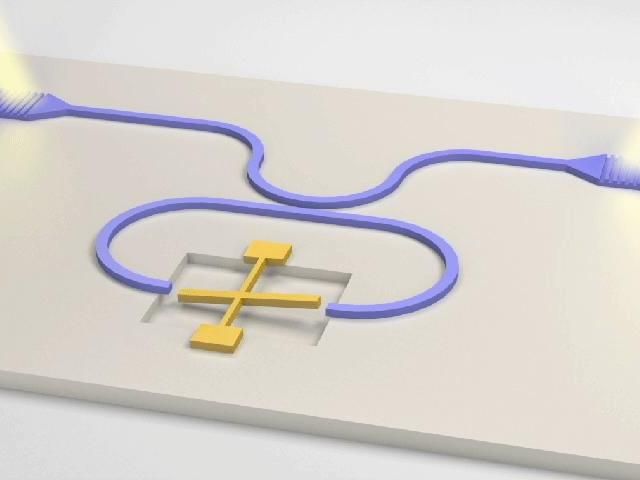Paving the way to extremely fast, compact computer memory
For decades, scientists have been studying a group of unusual materials called multiferroics that could be useful for a range of applications including computer memory, chemical sensors and quantum computers. In a study published in Nature, researchers from The University of Texas at Austin and the MPSD in Hamburg have demonstrated that the layered multiferroic material nickel iodide (NiI2) may be the best candidate yet for devices that are extremely fast and compact.
Multiferroics have a special property called magnetoelectric coupling, which means that you can manipulate magnetic properties of the material with an electric field and vice versa, electric properties with magnetic fields. The researchers found NiI2 has greater magnetoelectric coupling than any known material of its kind, making it a prime candidate for technology advances.
“Unveiling these effects at the scale of atomically thin nickel iodide flakes was a formidable challenge,” said Frank Gao, a postdoctoral fellow in physics at UT and co-lead author of the paper, “but our success presents a significant advancement in the field of multiferroics.”
“Our discovery paves the way for extremely fast and energy-efficient magnetoelectric devices, including magnetic memories,” added graduate student Xinyue Peng, the project’s other co-lead author.
Electric and magnetic fields are fundamental for our understanding of the world and for modern technologies. Inside a material, electric charges and atomic magnetic moments may order themselves in such a way that their properties add up, forming an electric polarization or a magnetization. Such materials are known as ferroelectrics or ferromagnets, depending on which of these quantities is in an ordered state.
However, in exotic materials that are multiferroics, such electric and magnetic orders co-exist. The magnetic and electric orders can be entangled in such a way that a change in one causes a change in the other. This property, known as magnetoelectric coupling, makes these materials attractive candidates for faster, smaller and more efficient devices. For these to work effectively, it is important to find materials with particularly strong magnetoelectric coupling.
The researchers accomplished this by exciting NiI2with ultrashort laser pulses in the femtosecond range (a millionth of a billionth of a second) and then tracking the resulting changes in the material’s electric and magnetic orders and magnetoelectric coupling via their impact on specific optical properties.
To understand why the magnetoelectric coupling is so much stronger in NiI2 than in similar materials, the team performed extensive calculations.
“Two factors play important roles here,” said co-author Emil Viñas Boström of the MPSD. “One of them is the strong coupling between the electrons’ spin and orbital motion on the iodine atoms — that’s a relativistic effect known as spin-orbit coupling. The second factor is the particular form of the magnetic order in nickel iodide, known as a spin spiral or spin helix. This ordering is crucial both to initiate the ferroelectric order and for the strength of the magnetoelectric coupling.”
Materials like NiI2 with large magnetoelectric coupling have a wide range of potential applications, according to the researchers. These include magnetic computer memory that is compact, energy efficient and much faster than existing memory systems; interconnects in quantum computing platforms; and chemical sensors that can ensure quality control and drug safety in the chemical and pharmaceutical industries.
The researchers hope that these groundbreaking insights can be used to identify other materials with similar magnetoelectric properties and that other material engineering techniques could possibly lead to a further enhancement of the magnetoelectric coupling in NiI2.
Original publication
Frank Y. Gao, Xinyue Peng, Xinle Cheng, Emil Viñas Boström, Dong Seob Kim, Ravish K. Jain, Deepak Vishnu, Kalaivanan Raju, Raman Sankar, Shang-Fan Lee, Michael A. Sentef, Takashi Kurumaji, Xiaoqin Li, Peizhe Tang, Angel Rubio, Edoardo Baldini; "Giant chiral magnetoelectric oscillations in a van der Waals multiferroic"; Nature, 2024-7-17
Other news from the department science
Most read news
More news from our other portals
See the theme worlds for related content
Topic world Sensor technology
Sensor technology has revolutionized the chemical industry by providing accurate, timely and reliable data across a wide range of processes. From monitoring critical parameters in production lines to early detection of potential malfunctions or hazards, sensors are the silent sentinels that ensure quality, efficiency and safety.

Topic world Sensor technology
Sensor technology has revolutionized the chemical industry by providing accurate, timely and reliable data across a wide range of processes. From monitoring critical parameters in production lines to early detection of potential malfunctions or hazards, sensors are the silent sentinels that ensure quality, efficiency and safety.

































































